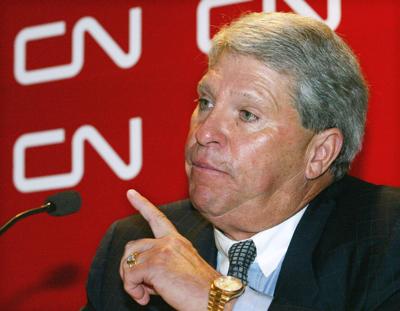Hunter HarrisonÔÇÖs spirit continues to hover.
Almost eight years after his death, the four-time rail CEO, who ran both Canadian railroads, is still mentioned in The Wall Street Journal when big news breaks.
The latest instance is Union PacificÔÇÖs (UNP) proposed $85 billion (U.S.) purchase of Norfolk Southern (NSC) to create a transcontinental carrier. TheyÔÇÖre two of North AmericaÔÇÖs Class 1 or biggest railroads. The others ÔÇö determined by revenue ÔÇö are Canadian National (CNR), Canadian Pacific Kansas City (CP), Burlington Northern Santa Fe (BNSF) and CSX.
Besides CNR and CP, Harrison also ran CSX and Illinois Central, swallowed by CN in 1998. Combined, these behemoths carry approximately 35 per cent of continental freight. Trucks shoulder the rest.
Harrison led the efficiency wave that followed the deregulation of rail in 1980 ÔÇö the most prominent proponent of Precision Scheduled Railroading, essentially moving freight trains according to a strict timetable.
Prior to this, trains only moved when a customerÔÇÖs load showed up at the yard, killing predictability and profitability. Imagine running an airline whose planes only depart when passengers showed up ÔÇö chaos.
Harrison was a managerial hard ass who didnÔÇÖt mind being known as one. He was also a mentor to those who wanted to learn how to move boxcars like him. These mentees are now in great demand, with a handful running todayÔÇÖs Class 1ÔÇÖs.
The CEO of Union Pacific, Jim Vena, is one of them, a former chief operating officer at CN. Norfolk SouthernÔÇÖs COO John Orr is also a CN alumnus, as is CSXÔÇÖs COO, Mike Cory. The CEO of CP, Keith Creel, was chief operating officer at CN, too, and is HarrisonÔÇÖs most famous prot├ęg├ę. Harrison lured Creel to CP in 2013 after coming out of retirement to turn around Canadian Pacific at the behest of an American activist investor.
Aside from Harrison being an efficiency nut, he became entranced with what big investors wanted. TheyÔÇÖd realized railroads are nonreplaceable infrastructure that can make gobs of money, especially with a hard-driving, knowledgeable operator like Harrison who knew how to move longer trains faster, commanding a premium for doing so.
Soon, the industry became driven by these major funds. They wanted Harrison clones running all the Class 1ÔÇÖs, replete with Harrison-like profits and share price increases.
Industry consolidation is of course braided with improved operating prowess.
When Harrison entered the industry in 1963, there were dozens of Class 1ÔÇÖs, but the number steadily shrunk. Starting in a Memphis rail yard pouring oil into the axles of boxcars for two dollars an hour, the railroad Harrison worked for was eventually bought by Burlington Northern.
Later, while running Illinois Central, he and the railroad were headhunted by no less than Michael Sabia, now CanadaÔÇÖs Clerk of the Privy Council, who was then CNÔÇÖs chief financial officer. Harrison became a CN man, instrumental in turning it into the most efficient railroad in North America.
During his first couple of years at CN (as COO), HarrisonÔÇÖs boss Paul Tellier tried to buy Kansas City Southern, but ditched it to pursue the bigger BNSF. There was a deal, complete with already-printed CNBN stationary, to create a transcontinental railroad like UNP and NSC have announced. But it faltered after a howl from competitors and then a regulatory moratorium on Class 1 mergers.
Still, CN tried to take a large piece of CSX, which also didnÔÇÖt materialize. Later, when Harrison ran CP, he unsuccessfully tried to buy CSX and Norfolk Southern. Near the end of his life, Harrison told me consolidation would occur ÔÇö not in his lifetime, but during the careers of younger railroaders like Creel.
As he predicted, the Mississippi, which divides the four American Class 1ÔÇÖs ÔÇö Union Pacific and BNSF to the west, and Norfolk Southern and CSX to the east ÔÇö is now being bridged.
Regulatory approval is not guaranteed, but since CN tried to buy BN, the world has changed. Post-pandemic, supply chains are in focus, and thereÔÇÖs a U.S. president who likes big, mighty and American.
What could it mean for a CN?
Since it tried buying Burlington Northern, BNSF was purchased by Warren BuffettÔÇÖs Berkshire Hathaway. Aside from long-term performance, Berkshire is known for its cash pile ÔÇö $334 billion (U.S.) as of March. If it doesnÔÇÖt buy CSX, it could easily acquire 25 per cent of CN, the legal limit for any shareholder.
That would give Berkshire effective control of a Canadian railroad that reaches the Gulf Coast, something the current president wouldnÔÇÖt mind either.
Harrison, if heÔÇÖs watching from above, would say I told you so.






























To join the conversation set a first and last name in your user profile.
Sign in or register for free to join the Conversation